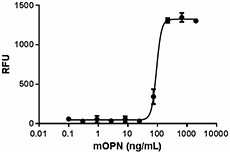- Regulatory Status
- RUO
- Other Names
- Secreted phosphoprotein 1 (SPP1, SPP-1), BNSP, Bone sialoprotein I (BSPI), Early T lymphocyte activation 1 protein (ETA1, ETA-1), OPN, OP

-

Immobilized recombinant mouse Osteopontin induces adhesion of HEK293 cells in a dose dependent manner. ED50 for this effect is 50 - 200 ng/mL. Calcein-AM was used to measure the number of adherent cells.
| Cat # | Size | Price | Quantity Check Availability | ||
|---|---|---|---|---|---|
| 763602 | 10 µg | $89.00 | |||
| 763604 | 25 µg | $147.00 | |||
| 763606 | 100 µg | $347.00 | |||
| 763608 | 500 µg | $932.00 | |||
Osteopontin (OPN), also known as secreted phosphoprotein 1 (SPP1) and early T lymphocytes activation 1 (ETA-1). OPN contains at its NH2-terminal, the RGD tripeptide sequence that can be bound by RGD-dependent integrins. OPN interacts with α9β1 and α4β1 integrins through a cryptic site of sequence SVVYGLR adjacent to the RGD motif. OPN interacts with integrins and CD44 as receptors. This protein has been shown to play roles in cell migration and survival, bone remodeling, regulation of immune cell functions, apoptosis, control of tumor cell phenotypes, and autoimmune diseases. OPN is involved in recruiting and stimulating macrophages and lymphocytes in response to microbial infections. Several inflammatory cytokines can induce OPN production, including TNF-α, IL-1β and IL-6. In OPN deficient mice, IFN-γ and IL-12 production were decreased, but IL-10 level was elevated, indicating that OPN might modulate cytokine production and promote type I immunity. The OPN receptor-ligand interaction mediates chemotaxis or attachment that depends on whether the protein is in soluble or immobilized form. OPN has also been shown to play a role in the progression of cancer, which is supported by the finding that patients who suffer from disseminated carcinoma also have increased levels of OPN in their plasma. In addition, OPN is a component of the human atherosclerotic plaque and may be a mediator of arterial neointima formation. It is synthesized by macrophage, smooth muscle, and endothelial cells in primary and recurrent human coronary atherosclerotic plaques, which may contribute to the cellular accumulations and dystrophic calcification in the atherosclerotic plaques. OPN is also a substrate for MMP-3, MMP-7, MMP-9, MMP-12, and thrombin within the SVVYGLR motif.
Product Details
- Source
- Mouse Osteopontin, amino acids (Leu17-Asn294) (Accession# BC057858), was expressed in 293E cells with a C-terminal 6xHis tag.
- Molecular Mass
- The 284 amino acid recombinant protein has a predicted molecular mass of approximately 31.56 kD. Both the DTT-reduced and non-reduced protein migrates at approximately 50 kD by SDS-PAGE. The predicted N-terminal amino acid is Leu.
- Purity
- >98%, as determined by Coomassie stained SDS-PAGE.
- Formulation
- 0.22 µm filtered protein solution is in PBS, pH 7.2.
- Endotoxin Level
- Less than 0.01 ng per µg cytokine (0.1 EU/ µg) as determined by the LAL method.
- Concentration
- 10 and 25 µg sizes are bottled at 200 µg/mL. 100 µg size and larger sizes are lot-specific and bottled at the concentration indicated on the vial. To obtain lot-specific concentration and expiration, please enter the lot number in our Certificate of Analysis online tool.
- Storage & Handling
- Unopened vial can be stored between 2°C and 8°C for up to 2 weeks, at -20°C for up to six months, or at -70°C or colder until the expiration date. For maximum results, quick spin vial prior to opening. The protein can be aliquoted and stored at -20°C or colder. Stock solutions can also be prepared at 50 - 100 µg/mL in appropriate sterile buffer, carrier protein such as 0.2 - 1% BSA or HSA can be added when preparing the stock solution. Aliquots can be stored between 2°C and 8°C for up to one week and stored at -20°C or colder for up to 3 months. Avoid repeated freeze/thaw cycles.
- Application
-
Bioassay
- Application Notes
-
BioLegend carrier-free recombinant proteins provided in liquid format are shipped on blue-ice. Our comparison testing data indicates that when handled and stored as recommended, the liquid format has equal or better stability and shelf-life compared to commercially available lyophilized proteins after reconstitution. Our liquid proteins are verified in-house to maintain activity after shipping on blue ice and are backed by our 100% satisfaction guarantee. If you have any concerns, contact us at tech@biolegend.com.
- Product Citations
-
Antigen Details
- Structure
- Monomer, secreted
- Distribution
-
Osteoblasts, osteoclasts, endothelial cells, macrophages, and smooth muscle cells.
- Function
- Plays a role in cell migration, survival, inhibition of calcification, and regulation of immune cell function. Hypocalcemia and hypophosphatemia leads to an increase in OPN transcription, translation, and secretion.
- Ligand/Receptor
- CD44, integrins (αVβ3).
- Bioactivity
- ED50 = 50 - 200 ng/mL as measured by the ability of immobilized protein to support the adhesion of HEK293 cells. Calcein-AM was used to measure the number of adherent cells.
- Biology Area
- Apoptosis/Tumor Suppressors/Cell Death, Cancer Biomarkers, Cell Biology, Cell Motility/Cytoskeleton/Structure, Immunology, Signal Transduction, Stem Cells
- Molecular Family
- Phospho-Proteins
- Antigen References
-
1. Wang KX and Denhardt DT. 2008. Cytokine Growth Factor Rev. 333.
2. Agnihotri R, et al. 2001. J. Biol. Chem. 276:28261.
3. O'Regan AW, et al. 2000. J. Leuko. Biol. 68:495.
4. Yokosaki Y, et al. 2005. Matrix Biol. 24:418.
5. Rangaswami H, et al. 2006. Trends Cell Biol. 16:79.
6. Ashkar S, et al. 2000. Science 287: 860.
7. Lee JL, et al. 2007. Cancer Res 67:2089. - Gene ID
- 20750 View all products for this Gene ID
- UniProt
- View information about Osteopontin on UniProt.org
